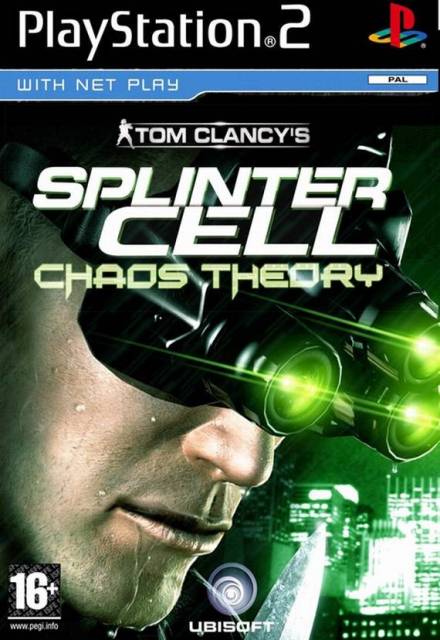
Over the last couple of weeks, I've been playing through Tom Clancy's Splinter Cell: Chaos Theory. Having now finished Sam Fisher's third outing (and consequently completed UbiSoft's original trilogy of Splinter Cell games), I feel like a brief blogging recap is in order. In particular I want to talk about how the game's presentation of choice affected my playthrough, both for better and for worse.
My history with the Splinter Cell franchise goes back to 2007, when I bought the original trilogy of games - Splinter Cell, Pandora Tomorrow, and Chaos Theory - for the collective total of £9.00 from a second-hand game store. I'd previously ignored the series in spite of its positive critical reaction, partly out of a ridiculous teenage fanboy loyalty to the Metal Gear franchise, but also because I was on a limited gaming budget and didn't want to risk gambling what little cash I had on something I wasn't even sure I'd like. By the time I was seventeen, my childish bias had left me and my income was steady, and so I decided to find out what I'd been missing out on. The short answer - one of the best stealth series ever conceived.
I played the original Splinter Cell in the summer of 2008, around the same time that Giant Bomb made its transition from a blog into a full-on website. It was one of the first games I ever blogged about, and my feelings towards the game weren't overwhelmingly positive. In my summary, I praised the game for its mechanics and vision, but criticised the way it masked its rigidity beneath the illusion of choice. When I eventually moved on to Pandora Tomorrow in the winter of 2009, I was happy to see that my criticisms had at least been partly addressed - the game granted the player more flexibility and was a little more forgiving, inviting experimentation and making Sam Fisher's job feel a little less like glorified trial-and-error.
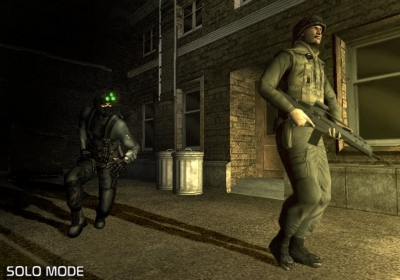
Chaos Theory builds further on those improvements, and the result is that it's without a doubt the best of the three Splinter Cell games I've played. A lot of the augmentations are minor (like the incorporation of an electronics disruptor into the pistol) or cosmetic (like the slew of new animations), but they make sense in terms of streamlining the techy, stealthy gameplay, and collectively they amount to a much more thrilling and rewarding sneaking experience. Arguably the biggest change from the first two games, though, is Chaos Theory's much more open-ended mission design. This is the deal-clincher - the design choice that addresses the issues of inflexibility that marred my enjoyment of the last two games. In some cases, there will be multiple paths through a level. In others, there will be multiple ways to achieve an objective. To cite an example, say there's a door locked with a keypad and guarded by two soldiers. In the original Splinter Cell, there would only be one way to get hold of that code and move through the door. In Chaos Theory, you have a multitude of options at your disposal. You could overhear a conversation between the two guards in which one accidentally lets the code slip. You could lure the guards into the shadows, take them hostage, and force them into divulging the code through interrogation. Or, if all else fails, you could use the super-spy equivalent of brute force and hack your way through the door after silencing the guards. Having these different means to the same end means that you're seldom forced into a situation where you can't progress, making Chaos Theory feel like a much more flexible (and much more forgiving) stealth-action game than its predecessors.
Having a choice as to how to move through each mission, and in turn shaping Fisher into the kind of super-spy you want him to be, is what I've wanted out of the Splinter Cell series ever since I played through the first game almost four years ago. What I didn't realise I wanted from a Splinter Cell game, but which Chaos Theory inadvertently provided me with, was a choice as to how to deal with my enemies. One feature that isn't included in either of its predecessors, as far as I can remember, is the way the game maps non-lethal takedowns to one shoulder button, and lethal ones to the opposite shoulder button. By juxtaposing the button-mapping in this way, every single hostage situation in Chaos Theory is turned into a very telling dichotomy - do I choke this guard unconscious, or do I deliver a fatal knee-strike to their lower back?
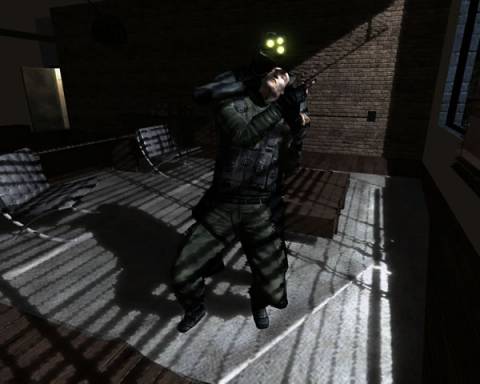
There are gameplay ramifications to this decision, albeit very minor ones. Non-lethality is rewarded with a higher end-of-mission ranking, while killing enemies eliminates the danger of patrolling guards waking their fallen comrades. The impact of these choices on me didn't arise from their effect on the gameplay, though. Instead, I admired the game for presenting the dichotomy in such a clear, up-front and immediate way. Sure, that choice was nothing new to the stealth genre at this point. Metal Gear Solids 2 and 3 featured tranquilizing weaponry and CQC to assist players wanting to play the non-lethal way, and Fisher's own SC-20K is capable of either lethal or non-lethal takedowns thanks to its impressive array of attachable gadgets. My point is that the decision to put an enemy down temporarily or permanently had always been a pre-empted one. By moving that choice into the immediate moment and bringing it down to a single button press, Chaos Theory forced me to consider in every single instance whether I wanted Fisher to be compassionate or ruthless. That forced consideration left me feeling a lot more attached not just to Fisher himself, but also to his enemies, to the point where the moral implications of each choice were more important than the impact it might have on the gameplay. As a consequence, almost every guard I encountered in Chaos Theory's ten-mission campaign escaped with his life. I'd like to think those few that didn't, didn't deserve to.
In spite of the myriad improvements present in Chaos Theory, and its indisputable position as the best of the first three Splinter Cell games, it's still a way from being everything it could have been. Sometimes the more open nature of the missions can feel a bit too open, to the point where I lost track of objectives on occasion (thankfully there's a useful Map option in the OPSAT that helped to get me back on track). The environment design also seems to actively discourage the use of some of Fisher's moves, most notably his trademark split jump, which I didn't find an opportunity to use at all. The biggest issue I had with the game was its slightly disappointing lighting effects. Splinter Cell and Pandora Tomorrow both did great jobs of making environments look dark without sacrificing any of their detail, but large portions of Chaos Theory's environments are simply caked in an inky blackness. I spent most of the game with Fisher's night-vision goggles engaged, not to augment my view of the environments, but just so I could see anything at all. It's not harmful from a gameplay perspective, but it still detracts a little from the experience, especially considering how good the lit portions of the environments look. All in all though, it's a brilliant package, and one that's still well worth playing, in my view.
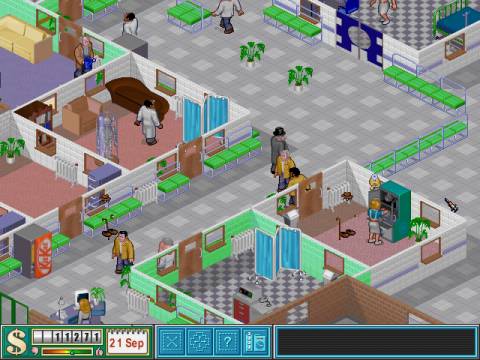
I'm not sure where I stand regarding future entries in the Splinter Cell series. Chaos Theory feels like a fitting end to the trilogy, and right now I don't feel any desire to pick up either Double Agent or Conviction. If any fans of the series would care to advise me how to proceed in that respect, I'd be grateful for your suggestions. In the meantime, I've got lots to keep me occupied. I'm currently playing Theme Hospital, an old childhood favourite that I recently downloaded to my PSP from the PlayStation Store. I don't typically play strategy games, but I'm having a lot of fun with this one. I'm just about to start the ninth scenario, and I'm loving the fairly simple mechanics and the dark sense of humour. I'm also playing Star Wars: Knights of the Old Republic on PC. Well, I say I'm playing it - I haven't actually touched it in the last couple of weeks, due to splitting my time between Chaos Theory and Theme Hospital, but I plan to get back into it now that my time with Third Echelon has come to an end. I'm on Dantooine at the moment, having just completed my Jedi training. Expect lengthier accounts of my experiences with both games as and when I finish them. For now, thanks very much for reading, and I'll see you around.
Dan
---
Currently playing - Theme Hospital (PSP)
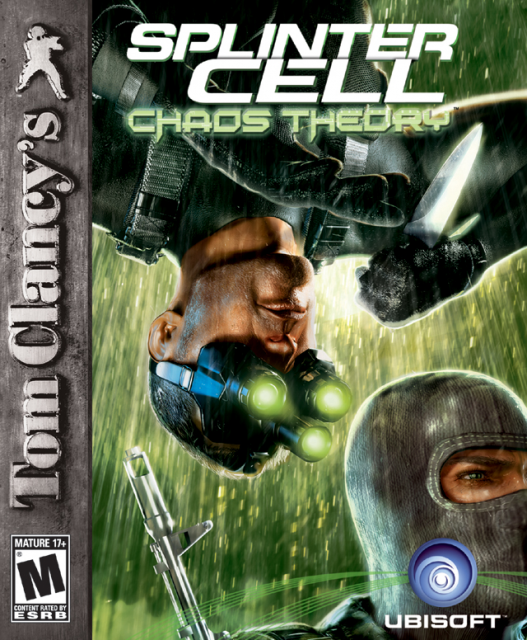
Log in to comment